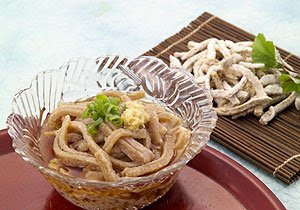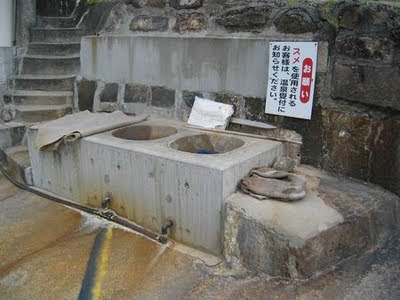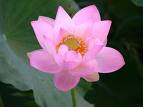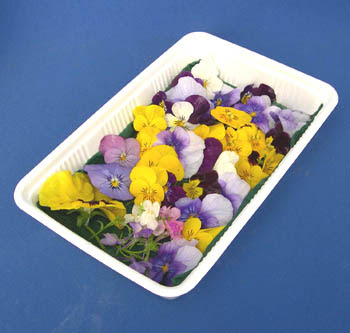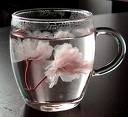::::::::::::::::::::::::::::::::::::::::::::::::::::::::::::::::::::::::::::::::::::::::::::::::::::
Curry (karee)
***** Location: Japan
***** Season: Topic
***** Category: Humanity
*****************************
Explanation
Curry is a dish of India, but in Japan it has taken on a life of its own.
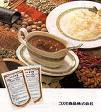
quote
Curry (カレー, karē) is one of the most popular dishes in Japan. It is commonly served in three main forms: curry rice (カレーライス, karē raisu), karē udon (thick noodles) and karē-pan (bread. Curry rice is most commonly referred to simply as 'curry' (カレー, karē).
A wide variety of vegetables and meats are used to make Japanese curry. The basic vegetables are onions, carrots, and potatoes. For the meat, beef, pork, chicken and sometimes duck are the most popular, in order of decreasing popularity. Katsu-karē is a breaded deep-fried pork cutlet with curry sauce.
Curry was introduced to Japan during the Meiji era (1869 - 1913),
at a time when India was under the administration of the British. The dish became popular and available for purchase in supermarkets and restaurants in the late 1960s. It has been adapted since its introduction to Japan, and is so widely consumed that it can be called a national dish.
As curry rice was introduced to Japan via English cuisine, it was originally considered to be Western cuisine.
original curry (オリジナルカレー, orijinaru karē), Japanese style
Curry sauce (カレーソース, karē sōsu) is served on top of cooked rice to make curry rice. Curry sauce is made by frying together curry powder, flour and oil, along with other ingredients, to make roux (ルー, rū); the roux is then added to stewed meat and vegetables, and then simmered until thickened. Adding potatoes to curry sauce was introduced by William S. Clark of the Sapporo Agricultural College, due to rice shortages at the time.
While curry roux and curry sauce are strictly speaking not the same, many people do not distinguish between the two, and it is common for people to ask for 'extra roux' (ルー増し, rū mashi) when ordering extra curry sauce in restaurants.
Instant curry roux カレールー was first sold in powder form by House Foods in 1926, and in block form by S&B Foods in 1956.
Vacuum-sealed curry sauce, prepared by heating the pouch in hot water or the microwave, is also popular.
dorai karē (ドライカレー) dry curry
yaki karē / yaki karee (焼きカレー)
© More in the WIKIPEDIA !
It comes in three basic tasts
sweet 甘口 amakuchi
medium 中辛 chuukara
hot 辛口 karakuchi
It is served in small stand-only shops in the stations, Indian restaurants or curry restaurants, where it is served extra in a silver bowl.

Indo karee インドカレー "Indian Curry"
:::::::::::::::::::::::::::::::::::::::::::::::::::::::::::::::::::::::::::::::::::::::::::::::::::::

Some Curry Specialities 日本のカレー
aroe karee アロエカレー aloe curry with Aloe vera
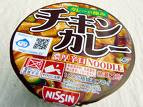
chikin karee チキンカレー chicken curry

Fujisan karee 富士山名物カレー "Curry a la Fujisan"
The rice is heaped like a little mountain top
. . . CLICK here for Photos !
:::::::::::::::::::::::::::::::::::::::::::::::::::::::::::::::::::::::::::::::::::::::::::::::::::::
Fukushima Curry specialities
karee chaahan カレーチャーハン fried rice with curry sauce
. . . CLICK here for Photos !
karee raamen カレーラーメン noodle soup with curry sauce
. . . CLICK here for Photos !
karee yakisoba カレーやきそば
fried noodles with curry sauce
. . . CLICK here for Photos !
:::::::::::::::::::::::::::::::::::::::::::::::::::::::::::::::::::::::::::::::::::::::::::::::::::::
. bengara karee ベンガラカレー Bengara Curry
from Fukiya village, Okayama
biifu karee ビーフカレ beef curry
from all kinds of famous Japanese beef varieties
. . . CLICK here for Photos !
... Matsusaka gyuu karee 松阪牛カレー Matsuzaka beef
Mie prefecture
. Gegege no Kitaro (ゲゲゲの鬼太郎) . Beef Curry
from Tottori, home of Mizuki Shigeru, Manga Painter
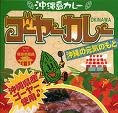
gooya karee ゴーヤーカレー bitter melon curry, goya curry
Okinawa
.................................................................................
gotoochi karee ご当地カレー "local curry"
from all the different regions of Japan

A shop in Kurashiki offers more than 60 varieties of local curry during the hot summer of 2010!
. . . CLICK here for more local curry Photos !
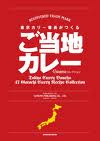
A Book with recipes from 47 prefectures of Japan.
.................................................................................
Hokkaido howaito karee 北海道ホワイトカレー white curry from Hokkaido
. . . CLICK here for Photos !

hokki karee ほっきカレー / ホッキカレー hokki shell curry
hokki long shell, Spisula sachalinensis.
Speciality of the Ainu in Hokkaido
. . . CLICK here for Photos !
hotate karee ほたてカレー scallop curry
Aomori
ishiyaki karee 石焼きカレー curry sauce with rice served in a heated stone bowl
. . . CLICK here for Photos !
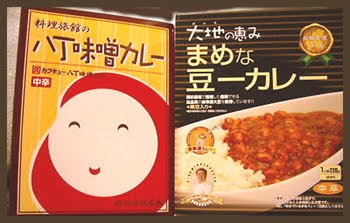
jikaree 地カレー "local curry"
prepared in small factories for the local people.
With hacho miso and beans and other ingredients.
kaki karee 牡蠣カレー oyster curry
Hiroshima
.................................................................................

karee aisu カレーアイスクリーム ice cream with curry flavor
. . . CLICK here for Photos !
karee bootoo カレーぼうとう / カレーホウトウcurry taste hootoo
from Yamanashi
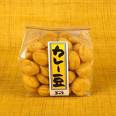
karee mame カレー豆 peanuts with curry flavor
Chiba prefecture
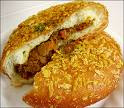
kareepan, karee pan カレーパン curry bread
This is very popular, especially with children.
karee raisu カレーライス curry rice cooked rice with curry
karee ramune カレーラムネ lemonade with curry flavor
. . . CLICK here for Photos !
karee soomen カレーそうめん cold soomen noodles with curry sauce
. . . CLICK here for Photos !
karee soosu カレーソース curry sauce
to poor on many dishes for additional flavor
. . . CLICK here for Photos !
.................................................................................

katsu karee カツカレー cotelette with curry sauce on rice
Because of the auspicious meaning of KATSU (to win) this is often eaten to pass an examination.
kiima karee キーマカレー keema curry, qeema curry
. . . CLICK here for Photos !
konan karee コナンカレー Conan curry
From Tottori, with Manga illustration cover
maaboo karee マーボーカレー Mabo-Curry
sauce mix with Chinese-flavored mabo-sauce
nashi karee 梨カレー nashi pear curry
Shimane
. . . CLICK here for Photos !
... seiyoo nashi karee 西洋梨カレー western pears curry
from Niigata
orientaru raisu オリエンタルライス oriental rice
a kind of dry curry, with low-fat salami from local cows. On top of this a special demi-glace curry sauce.
From Nemuro, Hokkaido
pooku karee ポークカレー pork curry
similar to beef curry, but with pieces of pork meat.
Not common in Osaka.
CLICK here for PHOTOS !
Potato Curry Pizza, Hokkaido Style
. . . CLICK here for Photos !
ringo karee リンゴカレー / りんごカレーapple curry
Nagano
. . . CLICK here for Photos !
saba karee サバカレー mackerel curry
Chiba
Made fresh or sold in tins.
. . . CLICK here for Photos !
shikaniku-iri karee raisu シカ肉入りカレーライス
curry rice with deer meat, Ezo-deer meat curry
Hokkaido
suupukaree, スープカレー soup curry
Curry ingredients are cut to big pieces and boiled in the soup. Vegetables, potatoes, carrots, paprica. Some even ladle this over boiled rice.
Sapporo, Hokkaido
tenpura karee 天ぷらカレー Tempura curry
. . . CLICK here for Photos !
udon karee, karee udon うどんカレー / カレーうどん
. . . CLICK here for Photos !

tsepperin karee ツェッペリンカレー Zeppelin Curry
Tsuchiura 土浦
yakuzen karee 薬膳カレー Yakuzen curry
bean curry cooked “yakuzen-style” (medicine food)
. . . CLICK here for Photos !
yasai karee 野菜カレー vegetable curry
. . . CLICK here for Photos !

Yokosuka kaigun karee よこすか海軍カレー from Yokosuka navy
Kanagawa,横須賀カレー
:::::::::::::::::::::::::::::::::::::::::::::::::::::::::::::::::::::::::::::::::::::::::::::::::::
Tokyo X buta 東京X豚 Tokyo X pork from special pigs
Often processed into a Tokyo Curry.
WASHOKU
Tokyo X buta 東京X豚 Pigs from Tokyo
*****************************
Worldwide use
INDIA SAIJIKI
Food from India
*****************************
Things found on the way
Daruma Curry だるまカレー

In Osaka
大阪市西成区天下茶屋1-18-20
Snowman Daruma Curry ゆきだるまカレー

and Daruma Curry served at Daruma Mountain in Izu
だるまカレー
source : potawind/darumayama 達磨山
*****************************
HAIKU and SENRYU
梅雨湿りカレーライスを食べにけり
tsuyu shimeri karee raisu o tabe ni keri
humid rainy season ...
I go out to eat some
curry rice
Wakimoto Maki 脇本 眞樹(塾長)
月曜日, 6月 29, 2009
http://333751044.blogspot.com/2009/06/blog-post_3891.html
Thank you, Wakimoto san.
:::::::::::::::::::::::::::::::::::::::::::::::::::::::::::::::::::::::::::::::::::::::::::::::::::::
carry on !
oh, curry on !
Indian Spices
spilling curry
on my khadi suit -
all natural colors
When I want to tease my Japanese friends asking about our stay in India, I tell them:
"We ate rice and curry for breakfast,
curry and rice for lunch and later
rice and curry for dinner."
Gabi Greve
India Saijiki
:::::::::::::::::::::::::::::::::::::::::::::::::::::::::::::::::::::::::::::::::::::::::::::::::::::
red hot pepper -
another fight over
Indian curry
Gabi Greve
my husband likes it REALY HOT !
WASHOKU
toogarashi 唐辛子 (とうがらし) red pepper, hot pepper
:::::::::::::::::::::::::::::::::::::::::::::::::::::::::::::::::::::::::::::::::::::::::::::::::::::
lamb korma
topped with crisp fried onions-
a labor of love
Claudia Cadwell
..........................................
curried pandan rice
I add a teaspoonful
of mango chutney
According to some recent scientific study, a regular dose of curry keeps Alzheimer's at bay.
Ella Wagemakers
..........................................
in the outhouse
the curry burns
a second time
Mike Keville
..........................................
dose of curry
wondering where I left
my dose of curry
Melinda Hipple
source : my facebook
June 2009
:::::::::::::::::::::::::::::::::::::::::::::::::::::::::::::::::::::::::::::::::::::::::::::::::::::
Indian delight...
the spouse adds spice
to life
Kumarendra Mallick
Hyderabad, whcIndia
:::::::::::::::::::::::::::::::::::::::::::::::::::::::::::::::::::::::::::::::::::::::::::::::::::::
The pot belly crackles
Idli's steaming in bamboo
Raindrops shatter the window
Idli is a steamed rice ball from south India.
source : Gerard, Wild Lotus Art
:::::::::::::::::::::::::::::::::::::::::::::::::::::::::::::::::::::::::::::::::::::::::::::::::::::
cold curry
lunch resumed after
a med call
bob (a medical worker)
people tend to want the ambulance just as we sit down to eat!
Happy Haiku Forum, July 2009
:::::::::::::::::::::::::::::::::::::::::::::::::::::::::::::::::::::::::::::::::::::::::::::::::::::
veggie fest
curry soya beans
with white rice
kenneth daniels (GY)
:::::::::::::::::::::::::::::::::::::::::::::::::::::::::::::::::::::::::::::::::::::::::::::::::::::
Click for enlargement
*****************************
Related words
***** WASHOKU : General Information
:::::::::::::::::::::::::::::::::::::::::::::::::::::::::::::::::::::::::::::::::::::::::::::::::::


